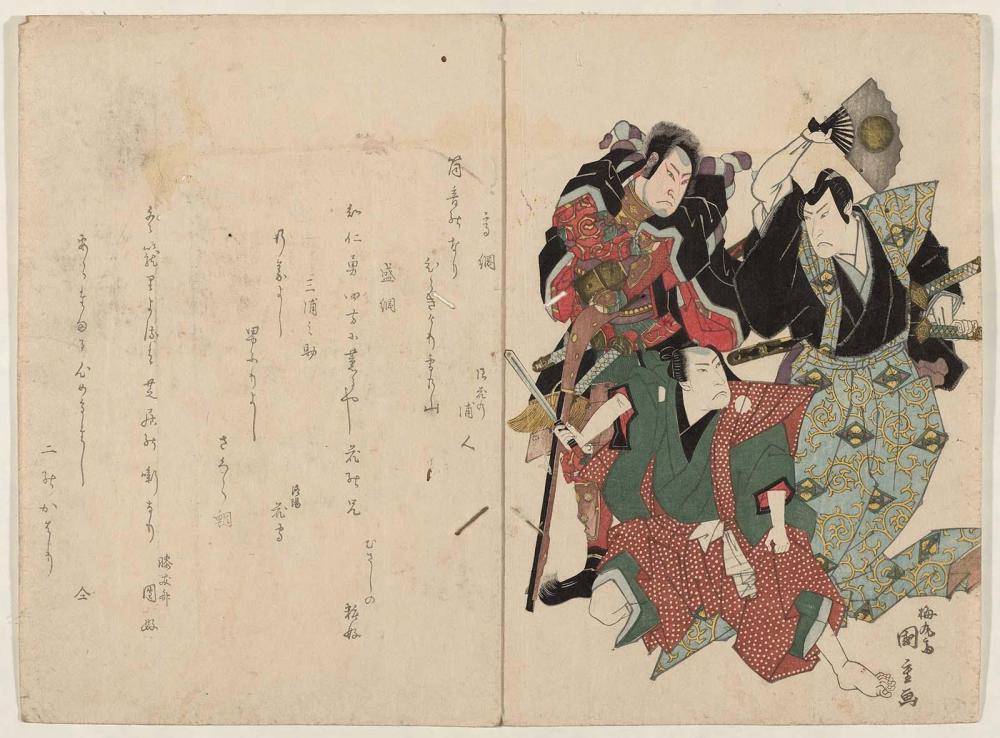Advanced Search 
高綱・三浦之助・盛綱 初代嵐橘三郎

Actor Arashi Kitsusaburô I (Rikan), formerly Arashi Kichisaburô II, in Three Roles: Takatsuna (right), Miuranosuke (center), Moritsuna (left)
高綱・三浦之助・盛綱 初代嵐橘三郎
Ryûsai Shigeharu (Japanese, 1803–1853)
Japanese
Edo period
1821 (Bunsei 4), 1st month
Medium/Technique
Woodblock print (surimono); ink and color on paper
Dimensions
Horizontal double ôban; 37.3 x 50.5 cm (14 11/16 x 19 7/8 in.)
Credit Line
William Sturgis Bigelow Collection
Accession Number11.26639
NOT ON VIEW
CollectionsAsia, Prints and Drawings
ClassificationsPrints
Catalogue Raisonné
Kitagawa, "Bosuton bijutsukan shozô Kamigata-e mokuroku" (Kansai daigaku, 2007), p. 89; Gerstle 2005, #195
DescriptionPlay: Ômi Genji Senjin Yakata
A surimono celebrating the actor's change of his official name, from Arashi Kichisaburô II to Arashi Kitsusaburô I; he continued to use his famous poetry name, Rikan, as a semi-official nickname. The inscription consists of four haikai poems and two additional lines reading "An auspicious change of heart (i.e. name change), in the second program of the theatrical season" (Aratameru kokoro medetashi, ni no kawari). The roles depicted, however, do not seem to have been played at this time and instead represent a major hit from the actor's past, a combination of three roles in the same play that he had played several times previously, beginning in 1805.
For translations of the poems, see Gerstle 2005, p. 215.
近江源氏先陣館(おうみげんじせんじんやかた)
A surimono celebrating the actor's change of his official name, from Arashi Kichisaburô II to Arashi Kitsusaburô I; he continued to use his famous poetry name, Rikan, as a semi-official nickname. The inscription consists of four haikai poems and two additional lines reading "An auspicious change of heart (i.e. name change), in the second program of the theatrical season" (Aratameru kokoro medetashi, ni no kawari). The roles depicted, however, do not seem to have been played at this time and instead represent a major hit from the actor's past, a combination of three roles in the same play that he had played several times previously, beginning in 1805.
For translations of the poems, see Gerstle 2005, p. 215.
近江源氏先陣館(おうみげんじせんじんやかた)
Signed
Baigansai Kunishige ga
梅丸斎国重画
梅丸斎国重画
InscriptionsPoem by Naniwa no Urabito, on the Takatsuna role: Tsutsu oto no/ narihibikikeri/ yuki no yama
Poem by Musashi no Shôkô, on the Moritsuna role: Chi jin yû/ yomo ni kaoru ya/ hana no ani
Poem by Rakuyô Kashu, on the Miuranosuke role: Gyôgi yoshi/ otoko-buri yoshi/ sakura-dai
Poem by Shitsuyûsai Dankô: Fuyu-gomori/ yoru wa shibai no/ hanashi nari
Poem by Musashi no Shôkô, on the Moritsuna role: Chi jin yû/ yomo ni kaoru ya/ hana no ani
Poem by Rakuyô Kashu, on the Miuranosuke role: Gyôgi yoshi/ otoko-buri yoshi/ sakura-dai
Poem by Shitsuyûsai Dankô: Fuyu-gomori/ yoru wa shibai no/ hanashi nari
ProvenanceBy 1911, purchased by William Sturgis Bigelow (b. 1850 - d. 1926), Boston [see note 1]; 1911, gift of Bigelow to the MFA. (Accession Date: August 3, 1911)
NOTES:
[1] Much of Bigelow's collection of Asian art was formed during his residence in Japan between 1882 and 1889, although he also made acquisitions in Europe and the United States. Bigelow deposited many of these objects at the MFA in 1890 before donating them to the Museum's collection at later dates.
NOTES:
[1] Much of Bigelow's collection of Asian art was formed during his residence in Japan between 1882 and 1889, although he also made acquisitions in Europe and the United States. Bigelow deposited many of these objects at the MFA in 1890 before donating them to the Museum's collection at later dates.
